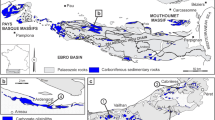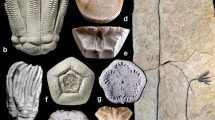Abstract
The slipper-like corallum ofCalceola sandalina comprises the calyx and the lid. It was generated by an anthozoan-like coral. Anthozoan polyps have a barrel-like shape that is produced and maintained by the activity of internal tethering elements and muscular structures in the body wall. All these structures counteract the hydrodynamics of the gastrovascular cavity.
In this reconstruction of the soft parts ofCalceola the functional aspects pointed out byRichter (1929) will be reviewed and revised and partially corrected.
Calceola was reconstructed on the basis of the model of rugose polyps. Consequently it consisted of single mesenteries which were added in four sectors in a serial manner. The lid was formed on the counter side and is explained as a bulge of the basal parts of the soft body. The lid was connected coherently by the mesenteries to the whole construction. It could be closed by contraction of the mesenteries and opened by regeneration of the hydraulic volume in the gastric cavity. As a mechanical consequence of moving the lid a straight hinge was developed between the calyx and the lid.
The soft body ofCalceola developed by quite simple structural modifications of a rugose coral. The most important modification was the bulging of the basal parts of the soft body on the counter side which formed the lid. This bulge enlarged the surface for adhesion to the substrate and might have been an advantage in survival as well. The soft body generated its own substrate giving it the specific slipper shape. This shape preventedCalceola from sinking into soft or muddy substrate by the principle of a snowshoe which also enabledCalceola to conquer new territories. The lid meant protection where enemies and pollution were concerned.
The slipper shape and the lid ofCalceola indicated a complex evolutionary pathway, but they evolved by simple modifications of an ancestor with a round diameter. The slipper shape is just a mechanical consequence of the possession of a flappable lid.
Kurzfassung
Das pantoffelförmige Kalkgerüst vonCalceola sandalina, bestehend aus einem Kelch und einem Deckel, wurde von einem Anthozoenpolypen gebildet. Diese Polypen haben eine tonnen- oder zylinderartige Körperform, die durch das Wechselspiel interner Verspannungselemente (Mesenterien), einer muskulär verspannten Außenwand und der als Hydroskelett wirkenden Gastralraumfüllung bestimmt wird.
Der Weichkörper vonCalceola ist nicht erhalten und muß darum rekonstruiert werden. Hierbei werden Aspekte der funktioneilen Überlegungen vonRichter (1929) zum Kalkgerüst und Weichkörper vonCalceola in einen konstruktionsmorphologischen Begründungszusammenhang eingebunden, ergänzt und teilweise korrigiert.
Der Polyp vonCalceola hatte, wie alle rugosen Korallen, Einzelmesenterien, die während der Individual-Entwicklung in Quadranten hinzuwuchsen. Der Deckel entstand durch Auswulstung der basalen Körperabschnitte in Richtung der Gegenseite. Dort wurde Karbonat produziert, so daß eine Kalkplatte (der Deckel) entstand, auf dem sich wie im Kelch die Mesenterienzwischenräume als Kalksepten abbildeten. Der Deckel konnte durch Kontraktion der Mesenterien verschlossen und durch Regeneration der Gastralfüllung geöffnet werden. Hierbei entstand durch mechanische Nötigung automatisch eine gerade Kante als Scharniergelenk zwischen Deckel und Kelch und damit die typische Pantoffelform.
Calceola entwickelte sich mit wenigen unspektakulären strukturellen Veränderungen aus einem Vorläufer ohne Deckel. Die wichtigste Veränderung war die Auswulstung der basalen Körperabschnitte auf der Gegenseite, von denen der Deckel gebildet wurde. Vorteil dieser Auswulstung ist eine größere Auflagefläche und damit verbunden auch die Adhäsionsfläche auf dem Substrat. Diese Form verhindert wie ein Schneeschuh das Einsinken in weiche oder schlammige Substrate, so daß entsprechende Lebensräume neu erschlossen werden konnten. Zusätzlich bot der Deckel Schutz vor Verschmutzung oder Freßfeinden. Der Deckel und die Pantoffelform vonCalceola entstanden aus konstruktiven Zwängen heraus und zeugen von einer Auseinandersetzung des Organismus mit seinem Lebensraum.
Similar content being viewed by others
Literatur
Birenheide, R. 1962. Die Typen der Sammlung Wedekind aus den Familien Cyathophyllidae und Stringophyllidae (Rugosa). -Senckenbergiana lethaea43 (2): 101–122, Frankfurt am Main.
— 1974a. Zur Herkunft der devonischen cystimorphen Rugosa. - Senckenbergiana lethaea54 (5/6): 453–473, Frankfurt am Main.
— 1974b. Die Typen und Typoide des Natur-Museums Senckenberg. - Die Typen der Sammlung Wedekind (Rugosa) von Gotland und vom Oslo-Gebiet (Ordovizium- Silurium). - Senckenbergiana lethaea54 (5-6): 475–489, Frankfurt am Main.
— 1990. Zur palökologischen Bedeutung des Stereoplasma in cystimorphen Deckelkorallen. - Natur und Museum120 (5): 129–138, Frankfurt am Main.
Franzen, J. 1997. Eine begründete Rekonstruktion der Evolution des Menschen? - Natur und Museum127 (8): 245–263, Frankfurt am Main.
Grasshoff, M. 1981a. Polypen und Kolonien der Blumentiere (Anthozoa); I, Der Bau der Polypen. - Natur und Museum111 (1): 1–8, Frankfurt am Main.
— 1981b. Polypen und Kolonien der Blumentiere (Anthozoa); III, Die Hexacorallia. - Natur und Museum111 (5): 134–150, Frankfurt am Main.
— 1984. Cnidarian Phylogeny - a biomechanical approach. - Palaeontographica Americana54: 127–135, Ithaca/New York.
Grasshoff, M. &Gudo, M. 1998a. Die Evolution der Coelenteraten - Teil I: Gallertoid-Korallen und Oktokorallen. - Natur und Museum128 (5): 129–138, Frankfurt am Main.
Grasshoff, M. &Gudo, M. 1998b. Die Evolution der Coelenteraten: Teil II: Solitäre und Koloniale Polypen. - Natur und Museum128 (10): 329–340, Frankfurt am Main.
Gudo, M. 1997a. Ist die Konstruktionsmorphologie ein aktualistisches Prinzip der Paläontologie ? - Courier Forschungs-Institut Senckenberg201 [Vogel-Festschrift]: 145–160, Frankfurt am Main.
— 1997b. Reconstruction of rugose corals - a constructional approach. - Fossil Cnidaria & Porifera26 (1): 9–16, Graz.
— 1997c. Konstruktionsmorphologische Rekonstruktion rugoser Korallen. - Profil11: 325–340, Stuttgart.
— 1998. The Soft Body ofCalceola sandalina: Summary of Morphological Reconstruction, Function, Ontogeny, and Evolutionary History. - Fossil Cnidaria & Porifera27 (1): 21–26, Graz.
- 1999. Konstruktion, Evolution und riffbildendes Potential rugoser Korallen. - Dissertation J. W. Goethe-Universität Frankfurt a. M. - 286 S., Frankfurt am Main.
- im Druck. Konstruktion und Evolution der paläozoischen Deckelkorallen. - Geologisch-Paläontologische Mitteilungen 24: Innsbruck.
Gutmann, W. F. 1966. Zu Bau und Leistung von Tierkonstruktionen (4-6). - 4. Bindegewebe und Muskulatur im Bewegungsapparat vonMetridium senile. - 5. Struktur und Mechanik des Bindegewebes beiUrticina felina undSagartia troglodytes. - 6. Funktionelle Gesichtspunkte zur Phylogenie der Coelenteraten: Radialsymmetrie und Muskelapparat. - Abhandlungen Senckenbergische Naturforschende Gesellschaft510: 1–106, Frankfurt am Main.
— 1972. Die Hydroskelett-Theorie. - Aufsätze und Reden Senckenbergische Naturforschende Gesellschaft21: 1–91, Frankfurt am Main.
— 1995. Die Evolution hydraulischer Konstruktion organismische Wandlung statt altdarwinistischer Anpassung.- Senckenberg Buch65: 1 -220, Frankfurt am Main (Kramer) [2. Auflage].
— 1997. Vom Lyellismus und Adaptationismus zur Konstruktions-Autonomie: Eine Studie zur Grundlagenproblematik der Paläontologie. - Courier Forschungs-Institut Senckenberg201 [Vogel-Festschrift]: 161–176, Frankfurt am Main.
Gutmann, W. F. &Bonik, K.1981. Kritische Evolutionstheo- rie - Ein Beitrag zur Überwindung altdarwinistischer Dogmen. - 227 S., Hildesheim (Gerster).
Hill, D. 1981. Rugosa and Tabulata. - [In:]Teichert, C. [ed.] Treatise on Invertebrate Paleontology, PartF (Supplement) 1. - 762 S., Boulder/Colorado and Lawrence/ Kansas (Geological Society of America and University of Kansas Press).
Hill, D. &Jell, J. S. (1969): On the rugose corals generaRhizophyllum Lindström,Platyphyllum Lindström andCalceola Lamarck. - Neues Jahrbuch für Geologie und Paläontologie, Monatshefte1969: 534–551, Stuttgart.
Lafuste, J. 1983. Disparité microstructurale entreCalceola Lamarck etGoniophyllum Dybowski (Tetracoralla, Devonien et Silurien). - Compte rendu hebdomadaire des Séances de l’Académie des Sciences296: 1749–1752, Paris.
Neumann, B.E. 1988. Some aspects of life strategies of early Palaeozoic rugose corals. - Lethaia21 (2): 97–114, Oslo.
— 1984. Origin and early evolution of rugose corals. - Palaeontographica Americana54: 119–126, Ithaca/New York.
Jell, J.S. 1984. Cambrian Cnidarians with mineralized skeletons. - Palaeontographica Americana54: 105–109, Ithaca/New York.
Jell, P.A. &Jell, J.S. 1976. Early Middle Cambrian corals from western New South Wales. - Alcheringa1: 181–195, Sydney.
Richter, R. 1929. Das Verhältnis von Funktion und Form bei den Deckelkorallen. - Senckenbergiana11: 57–94, Frankfurt am Main.
Schäfer, W. 1962. Aktuo-Paläontologie nach Studien in der Nordsee. - 666 S., Frankfurt am Main (Kramer).
— 1980. Fossilien - Bilder und Gedanken zur Paläontologischen Wissenschaft. - 244 S., Frankfurt am Main (Kramer).
Stolarski, J. 1993. Ontogenetic development and functional morphology in the early growth-stages ofCalceola sandalina (Linnaeus, 1771). -[In:] Oekentorp-Küster, P. [ed.] Proceedings of the VI. International Symposium on Fossil Cnidaria and Porifera held in Münster, Germany 9.–14. September 1991. - Courier Forschungs-Institut Senckenberg201: 161–176, Frankfurt am Main.
Wedekind, R. 1924. Das Mitteldevon der Eifel. - 1. Teil: Die Tetrakorallen des unteren Mitteldevon. - Schriften Gesellschaft Naturwissenschaften Marburg14: 1–93, Marburg.
— 1927. Die Zoantharia Rugosa von Gotland. - Sveriges Geologiska Undersökning19: 1–95, Stockholm.
— 1937. Einführung in die Grundlagen der Historischen Geologie. 2. Mikrobiostratigraphie. Die Korallen- und Brachiopodenzeit. - 136 S., Stuttgart (Enke).
Wright, A. im Druck. A new Early Devonian operculate coral from eastern Australia. - Records of the Western Australian Museum, Supplement 58: Perth.
Author information
Authors and Affiliations
Corresponding author
Rights and permissions
About this article
Cite this article
Gudo, M. Die Weichkörperkonstruktion vonCalceola sandalina (Rugosa, Anthozoa) — Konstruktionszusammenhänge, Ontogenese, Evolution und Funktionsweisen. Paläont. Z. 74, 37–49 (2000). https://doi.org/10.1007/BF02987950
Received:
Accepted:
Issue Date:
DOI: https://doi.org/10.1007/BF02987950




